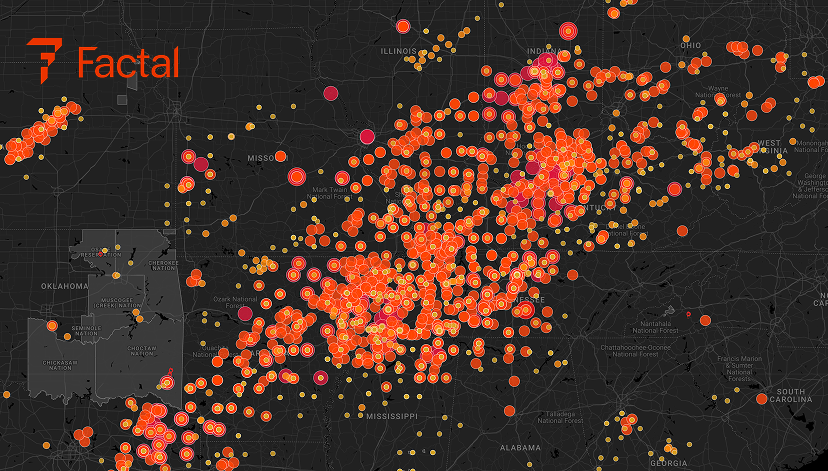When you ask Factal editors to rank the most difficult critical events to cover in real time, tornado outbreaks are often at the top of the list.
“Covering tornadoes on the ground can be challenging,” Factal NORAM evening shift editor Theresa Seiger explained. “They often happen in the afternoon or night, when staffing may be lower at news outlets and when it’s harder to see that a tornado is on the ground.”
Together with the late hour, the sheer volume of tornado warnings and reports can be overwhelming. (The map above shows the first two weeks of April alone.) The trick is detecting which tornado paths are the most dangerous. Seiger and the Factal team of journalists draw from eyewitnesses, storm chasers, local media and live weather maps to identify damaging tornadoes while they’re still on the move. Security and disaster response teams can sift through the dozens of tornado warnings to prioritize which areas are facing the greatest risk and require the most urgent response.
“Though doppler radar might indicate that a tornado has spun up, it takes visual confirmation to verify one in a given area,” Seiger said. “And the issue is complicated when tornadoes hit rural areas that might not have as many reporters in the area.”
Over the last few years, tornado behavior is changing, spawning larger clusters that stretch into the late-night hours. As opposed to isolated tornadoes that come and go, outbreaks can follow a directional pattern over several hours. Outbreaks live longer and cover more ground, causing more damage along the way.
“There is still a lot that we don’t understand about what makes a storm spawn a tornado when comparable storms don’t,” Seiger said. “The classic image we have of Tornado Alley is also shifting.”
Tornado season arrived earlier this year, driven by the the Gulf of Mexico’s relative heat. Three major outbreaks in March and early April spawned more than 280 tornadoes and left at least 75 people dead. Factal published hundreds of updates in real time – a blend of automated weather warnings and editor-verified updates that alerted Factal members whenever they had employees or facilities nearby.
These storms also knocked out power and cell towers, cutting off employees from emergency communications. Travelers faced added risk, often navigating unfamiliar areas without reliable alerts. With a Factal integration, EVERYWHERE Communications provides a continuous communication link—even in the most challenging conditions.

Join Factal and EVERYWHERE on Wednesday, April 23, for a 30-minute webinar to learn how to cut through the noise during tornado outbreaks. We’ll share best practices and demonstrate how both Factal and EVERYWHERE come together to keep people safe. Register here to attend.

